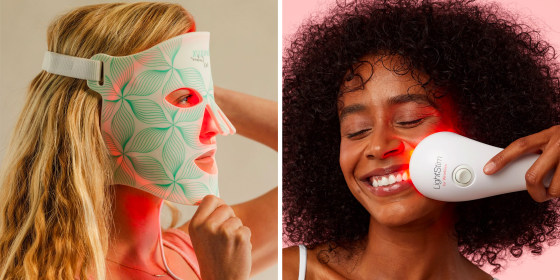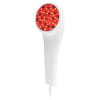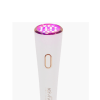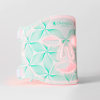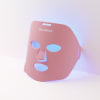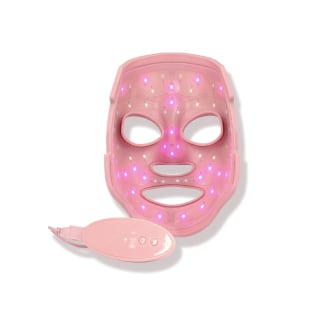If you’ve stumbled into red light therapy videos on social media, you’ve probably heard that it clears acne, reduces wrinkles, reduces inflammation, and heals joints. You may have also heard that it does nothing and is just another trend. The truth is that red light therapy has many potential benefits, but according to our experts, it hasn’t been studied enough to back all of those supposed benefits — at least, not yet.
Even so, dozens of light therapy devices are available online, all purported to have myriad skin benefits. We spoke with experts to better understand what red light therapy is, how it works and what to look for when considering an at-home red light therapy device.
SKIP AHEAD The best red light therapy tools in 2025 | Does red light therapy work? | Why trust NBC Select?
What is red light therapy?
Red light therapy, sometimes called photobiomodulation, applies specific wavelengths of light (usually around 630 nanometers) onto your skin. These wavelengths can penetrate two to three millimeters below the skin, and cause positive reactions in the cells just under your skin, says Dr. Apple Bodemer, a board-certified dermatologist and professor at the University of Wisconsin School of Medicine and Public Health.
Specifically, a type of cell organelle called mitochondria absorb the light, stimulating the cell, says Dr. Nkem Ugonabo, a board-certified dermatologist at Union Derm in New York City. Stimulated mitochondria are beneficial because they can produce more energy and be more active, increasing collagen production, says Dr. Jaimie DeRosa, founder and lead physician of DeRosa Center Plastic Surgery and Med Spa. Red light therapy can also increase blood circulation to tissues, providing anti-inflammatory benefits, she says.
At least, that’s the idea. There aren’t a lot of high-quality scientific studies available, and many of the red light therapy studies are funded by companies that make red light products, which should be taken with a grain of salt, says Bodemer. But there seems to be enough evidence that red light therapy may be helpful for some people, she says.
How we picked the best red light therapy devices
When shopping for an at-home red light therapy tool, here’s what we kept in in mind after speaking with experts:
- FDA-cleared: Devices that are cleared by the Food and Drug Administration (FDA) will signify that the product has been submitted to and reviewed by the FDA, says Bodemer. (More on FDA terminology later.) We only selected FDA-cleared products and included a link to each product’s specific FDA-clearance paperwork below our recommendation.
- LED colors: Many products come with multiple LED light sources (wavelengths), not just red. If you’re focused on treating fine lines and inflammation, red light should be your focus. If you’re also interested in combating blemishes, a blue light device can be helpful, as it targets bacteria in the skin, says Bodemer. We included products that have a variety of light-emitting diode (LED) colors built-in.
- Device type: Most at-home devices are either wands you hold over a specific skin spot or masks you strap onto your face. Wands are typically more affordable than masks but require more effort since you have to manually hover the device over each spot you want to treat for a few minutes. We included multiple wands and masks in our recommendations.
- Price: Red light therapy tools can range from $100 to over $1,000. Red light therapy wands are typically lower priced than masks and are a better entry point for light-curious shoppers. Most of our recommendations cost $400 or less.
Want more from NBC Select? Sign up for our newsletter, The Selection, and shop smarter.
The best red light therapy tools in 2025
Our experts recommend speaking with your healthcare provider before using a red light device. Follow your doctor’s and manufacturer’s advice carefully, and know that individual results vary.
Best red light wand: LightStim for Wrinkles Wand
- Simple to use
- Competitive price point
- Must be plugged in to use
Bodemer recommends the Lightstim brand if you’re looking for FDA-cleared light therapy wands. This wand has various wavelengths of red LED light that treat fine lines and wrinkles — the brand also has wands of different light wavelengths for pain relief and acne treatment.
The Lightstim Wrinkles wand is one of the simplest tools on our list: you plug it in to a wall outlet for power, and use the on-off switch in the center of the wand for treatment. LightStim recommends using the wand for no more than three minutes per treatment area, five to seven times weekly.
FDA-cleared: yes | Light spectrum: red | Recommended treatment time: 3 mins. per area | Power: wired, plug in
Budget red light wand: Revive Light Therapy Lux Collection Glo
- Low price
- Multiple light colors
- Wireless
- Targets a very small area
Revive Light Therapy, which comes recommended by Bodemer, makes smaller, lower-priced FDA-cleared wands that target very specific areas of skin rather than your whole face. This Lux Collection Glo wand can emit red and blue light, suitable for targeting fine lines or bacteria respectively. It’s great for targeting skin condition spots like acne and inflammation, and because it’s small and rechargeable, it’s easy to travel with, according to online reviews.
FDA-cleared: yes | Light spectrum: red, blue | Recommended treatment time: 3 mins. per area | Power: wireless, rechargeable
Staff-favorite red light mask: Solawave Wrinkle Face Mask
- Competitive price (for a mask)
- Single-strap fit can be tricky
NBC Select editorial director Lauren Swanson tested a previous version of the Solwave LED light mask for about a month. While she didn’t notice any dramatic changes (or side effects), she did see subtle, positive shifts in her skin tone following the recommended 10-minute treatment time, at least three days a week. The mask is connected by a wire to a small remote that acts as both the controller and the rechargeable battery for the device.
FDA-cleared: yes | Light spectrum: red | Recommended treatment time: 10 mins. | Power: rechargeable controller, wired between controller and mask
Expert-recommended red light mask: Omnilux Contour Face
- Competitive pricing
- Comes with travel adapters
- Nothing to note at this time
Consider Omnilux for light therapy masks with FDA-clearance, says Bodemer. This Contour Face mask is very similar to the Solawave mask: both use red and near-infrared light LEDs to target wrinkles, redness and more. The Contour Face mask comes with two head straps and travel adapters for US, UK, EU and Australia so if you’re a frequent traveler, this might be the best option for you. The brand recommends using it for no more than 10 minutes a day, four to six times a week.
FDA-cleared: yes | Light spectrum: red | Recommended treatment time: 10 mins. | Power: rechargeable controller, wired between controller and mask
Best red and blue light mask: Dr. Dennis Gross DRx Spectralite Faceware Pro
- Short treatment time
- Wireless
- Red and blue LEDs
- Pricey
NBC Select associate reporter Ashley Morris wrote our review of the Dennis Gross DRx Spectralite Faceware Pro after receiving a sample from the brand, and still uses it a few times a week. It has both red and blue LEDs to target fine lines and acne respectively, you can turn on one or both colors per treatment. Its treatment time is three minutes — the shortest of all our recommended masks.
Morris uses both the red and blue lights for her treatments, usually right after her morning shower. “When I use the mask consistently, my skin has a smoother texture and overall clearer complexion,” says Morris. It’s also helped her target mild breakouts and occasional flare ups.

FDA-cleared: yes | Light spectrum: red, blue | Recommended treatment time: 3 mins. | Power: wireless, rechargeable
Best premium red light mask: MZ Skin Lightmax Supercharged LED Mask 2.0
- Red and blue lights
- Comes with travel adapters
- Flexible silicone mask
- Pricey
This premium, FDA-cleared light mask is made of silicone, and more comfortably wraps around the contours of your face than hard-plastic alternatives, according to online reviews. While it is much pricier than other options on our list, it has both red and blue light LEDs, comes with travel adapters for the US, UK, EU and Australia and comes recommended by DeRosa. The travel adapters and wireless, rechargeable controller make it well-suited to frequent flyers who want to easily take their skin care routine with them.
FDA-cleared: yes | Light spectrum: red, blue | Recommended treatment time: 10 mins. | Power: rechargeable controller, wired between controller and mask
Does red light therapy work?
Light therapy has been used in medical and scientific fields for decades and you may see doctors use it to combat seasonal affectiveness disorder, treat scars and more in their patients.
More specifically, red light therapy has the potential to be an effective treatment for acne, decreasing healing time after certain procedures, and stimulating hair growth, says Ugonabo.
Red light therapy for general facial rejuvenation is less studied, however, according to Bodemer. We don’t yet have enough human studies to make definitive claims about reducing wrinkles, plumping skin or treating photoaging.
Red light therapy remains exciting because of the proven positive effects of other forms of light therapy. Infrared light, for example, has been used to treat joint pain for years, says Bodemer.
Meet our experts
At NBC Select, we work with experts who have specialized knowledge and authority based on relevant training and/or experience. We also take steps to ensure all expert advice and recommendations are made independently and without undisclosed financial conflicts of interest.
- Dr. Apple Bodemer is a board-certified dermatologist and professor of dermatology at the University of Wisconsin School of Medicine and Public Health.
- Dr. Nkem Ugonabo is a board-certified dermatologist at Union Derm in New York City.
- Dr. Jaimie DeRosa is a double board-certified plastic and reconstructive surgeon and the lead physician and founder of DeRosa Center Plastic Surgery and Med Spa in Boston, Massachusetts.
Why trust NBC Select?
I’m a reporter at NBC Select who covers technology and fitness including recent stories on the best smartwatches, air purifiers, and over-ear headphones. To better understand the nuances of red light therapy, I spoke with three dermatologists as well as NBC Select staff who’ve tried at-home light treatments.
Catch up on NBC Select’s in-depth coverage of tech and tools, wellness and more, and follow us on Facebook, Instagram, Twitter and TikTok to stay up to date.
